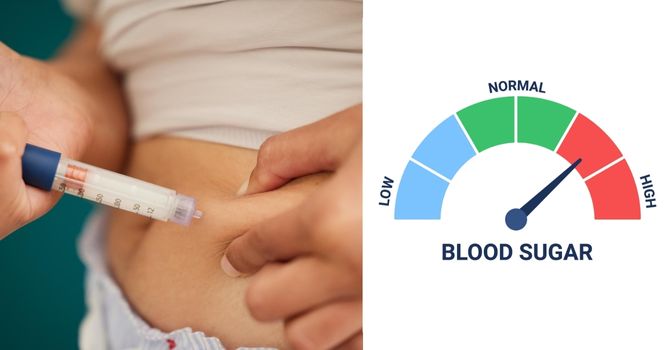Diabetes Mellitus Definition
Diabetes is characterised by a state of chronic high blood sugar, resulting from different root causes, environmental or genetic or both acting jointly.
There is either defective production or action of Insulin; The hormone which controls glucose, fat and amino acid metabolism.
Chronic High Blood Sugar leads to serious damage to heart, blood vessels, eyes, kidneys and nerves.
Around 30 Million people in United States have Diabetes, which accounts for around 10% of the population. Out of which 1.5% have Type 1 diabetes and the rest have type 2 .
Accoring to World Health Organisation, 422 million people worldwide have diabetes and around 1.5 million die every year due to diabetes.
In this article, we will look into, difference between diabetes type 1 and type 2
Cause of Diabetes type 1
The cause of diabetes type 1 is immune mediated in 90% of the cases and the reason is unknown in 10%.
Immune-mediated means the body destroys its own cells, which produce insulin namely, Pancreatic beta cells. The rate at which the beta cells of the pancreas are destroyed is variable
Cause of Diabetes type 2
The underlying cause is lack of action of hormone insulin, which helps cells to utilise sugar as a source of energy. The lack of action of insulin is attributed to being overweight and leading a sedentary life.
Sign and Symptoms of Diabetes Type 1
The onset is abrupt and may occur suddenly
- Frequent Urination
- Thirst
- Hunger, which is constant
- Weight loss, despite normal or increased appetite
- Blurred Vision
- Postural Hypotension
- Fatigue
Signs and Symptoms of Diabetes Type 2
- Increased Urination
- Thrist
While increased urination and thirst may be presenting complaints, most of the patients remain asymptomatic, that is without any symptoms.
- Hunger, which is constant
- Weight Loss
- Chronic Skin conditions
- Generalised Pruritus or Itching
- Vision Disturbances
- Fatigue
- Balanoposthitis (Inflammation of the foreskin and glans in uncircumcised males)
The symptoms in type 2 are less marked, and the diagnosis is several years after onset . That’s why it is important to know the risk factors
Diabetes Type 1 Risk Factors
It’s Hereditary and approximately one-third of disease susceptibility is due to genes and two-thirds to environmental factors.
Most patients of type 1 have circulating antibodies to islet cells ICA
A child whose mother has type 1 diabetes has 3% chance of developing the disease and 6% chance if the Child’s father has it.
Environmental factors which contributed to more than two-thirds are due to observation that it is more common in Scandinavian countries, like Denmark, Norway, Sweden ,Finland, Iceland and less common as we move closer to the equator.
Also the risk for type 1 diabetes increases in people (who normally have low risk), when they emigrate to the northern Hemisphere.
Scientists still couldn’t pin point to which environmental factor is causing it and increasing evidence is about the improvements in public health and reduced infections especially parasitic infections, could lead to dysregulation of the immune system, which might lead to asthma and type 1 diabetes.
Who is at risk for Diabetes Type 2
Genetic and environmental factors are major risk factors, both combine to cause insulin resistance and loss of beta cells in the pancreas.
People who are Obese are at risk and Obesity is the major environmental factor causing insulin resistance.
Prevalence of Obesity differs in different populations. It is not apparent in no more than 30% of Chinese or Japanese but evident in more than 60% to 70% of North Americans, Europeans and Africans.
Visceral obesity, which is accumulation of fat around the organs, is linked to insulin resistance. That calls to watch out for the increasing waistline.

The risk increases with increase in age.
Leading a sedentary lifestyle ups the risk , while High Blood Pressure and abnormal Lipid Profile are the risk factors to watch out for.
Diagnosis of Diabetes Type 1
The following are essential for Diagnosis of Diabetes Type 1
- Polyuria (Production of abnormally large volume of dilute urine),
Polydipsia (Abnormally great thirst) and
Weight Loss associated with random plasma glucose of 200 mg/dL or more
- Plasma Glucose of 126 mg/dL or more after an overnight fast, on more than one occasion
- Ketonemia (Abnormally high levels of ketones in the blood) and Ketonuria (Presence of ketones in Urine) or Both
- Presence of Islet autoantibodies
Diagnosis of Type 2 Diabetes
The following are essential for diagnosis of diabetes type 2
- Many patients have few or no symptoms
- Obese and mostly over age 40 years.
- Polyuria, Polydipsia, ketonuria and Weight Loss are uncommon at the time of diagnosis.
- Plasma Glucose of 126 mg/dL or more after an overnight fast on more than one occasion.
- 2 hours after 75g Oral Glucose, plasma level of 200 mg/dL or more
- HbA1c of 6.5% or more
- Hypertension, Dyslipidemia and Atherosclerosis are often associated.









